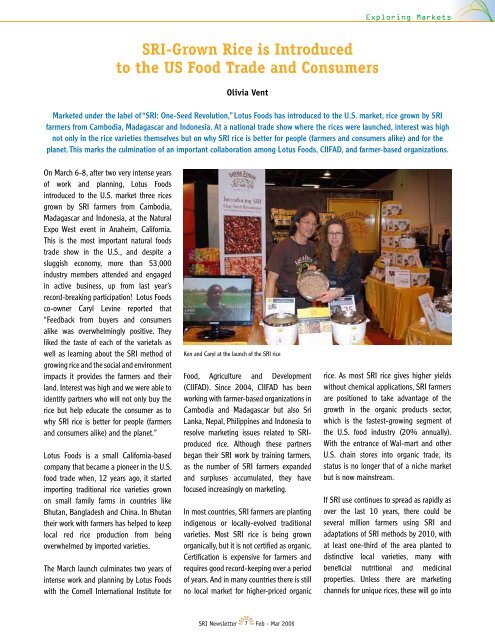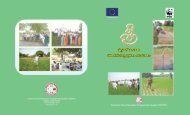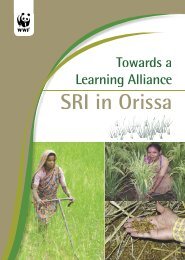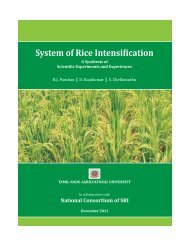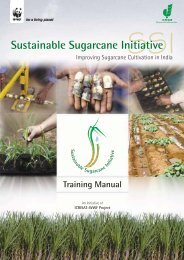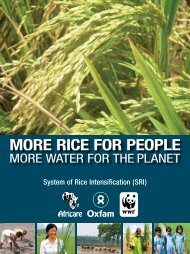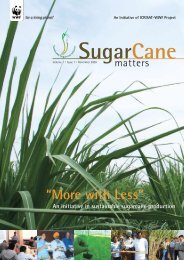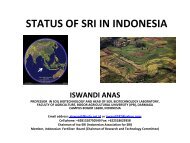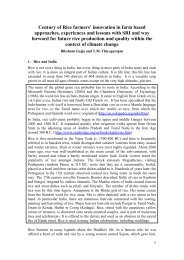Stretching Out SRI in Tamil Nadu - SRI - India
Stretching Out SRI in Tamil Nadu - SRI - India
Stretching Out SRI in Tamil Nadu - SRI - India
You also want an ePaper? Increase the reach of your titles
YUMPU automatically turns print PDFs into web optimized ePapers that Google loves.
<strong>SRI</strong>-Grown Rice is Introduced<br />
to the US Food Trade and Consumers<br />
Olivia Vent<br />
Marketed under the label of “<strong>SRI</strong>: One-Seed Revolution,” Lotus Foods has <strong>in</strong>troduced to the U.S. market, rice grown by <strong>SRI</strong><br />
farmers from Cambodia, Madagascar and Indonesia. At a national trade show where the rices were launched, <strong>in</strong>terest was high<br />
not only <strong>in</strong> the rice varieties themselves but on why <strong>SRI</strong> rice is better for people (farmers and consumers alike) and for the<br />
planet. This marks the culm<strong>in</strong>ation of an important collaboration among Lotus Foods, CIIFAD, and farmer-based organizations.<br />
On March 6-8, after two very <strong>in</strong>tense years<br />
of work and plann<strong>in</strong>g, Lotus Foods<br />
<strong>in</strong>troduced to the U.S. market three rices<br />
grown by <strong>SRI</strong> farmers from Cambodia,<br />
Madagascar and Indonesia, at the Natural<br />
Expo West event <strong>in</strong> Anaheim, California.<br />
This is the most important natural foods<br />
trade show <strong>in</strong> the U.S., and despite a<br />
sluggish economy, more than 53,000<br />
<strong>in</strong>dustry members attended and engaged<br />
<strong>in</strong> active bus<strong>in</strong>ess, up from last year’s<br />
record-break<strong>in</strong>g participation! Lotus Foods<br />
co-owner Caryl Lev<strong>in</strong>e reported that<br />
“Feedback from buyers and consumers<br />
alike was overwhelm<strong>in</strong>gly positive. They<br />
liked the taste of each of the varietals as<br />
well as learn<strong>in</strong>g about the <strong>SRI</strong> method of<br />
grow<strong>in</strong>g rice and the social and environment<br />
impacts it provides the farmers and their<br />
land. Interest was high and we were able to<br />
identify partners who will not only buy the<br />
rice but help educate the consumer as to<br />
why <strong>SRI</strong> rice is better for people (farmers<br />
and consumers alike) and the planet.”<br />
Lotus Foods is a small California-based<br />
company that became a pioneer <strong>in</strong> the U.S.<br />
food trade when, 12 years ago, it started<br />
import<strong>in</strong>g traditional rice varieties grown<br />
on small family farms <strong>in</strong> countries like<br />
Bhutan, Bangladesh and Ch<strong>in</strong>a. In Bhutan<br />
their work with farmers has helped to keep<br />
local red rice production from be<strong>in</strong>g<br />
overwhelmed by imported varieties.<br />
The March launch culm<strong>in</strong>ates two years of<br />
<strong>in</strong>tense work and plann<strong>in</strong>g by Lotus Foods<br />
with the Cornell International Institute for<br />
Ken and Caryl at the launch of the <strong>SRI</strong> rice<br />
Food, Agriculture and Development<br />
(CIIFAD). S<strong>in</strong>ce 2004, CIIFAD has been<br />
work<strong>in</strong>g with farmer-based organizations <strong>in</strong><br />
Cambodia and Madagascar but also Sri<br />
Lanka, Nepal, Philipp<strong>in</strong>es and Indonesia to<br />
resolve market<strong>in</strong>g issues related to <strong>SRI</strong>produced<br />
rice. Although these partners<br />
began their <strong>SRI</strong> work by tra<strong>in</strong><strong>in</strong>g farmers,<br />
as the number of <strong>SRI</strong> farmers expanded<br />
and surpluses accumulated, they have<br />
focused <strong>in</strong>creas<strong>in</strong>gly on market<strong>in</strong>g.<br />
In most countries, <strong>SRI</strong> farmers are plant<strong>in</strong>g<br />
<strong>in</strong>digenous or locally-evolved traditional<br />
varieties. Most <strong>SRI</strong> rice is be<strong>in</strong>g grown<br />
organically, but it is not certified as organic.<br />
Certification is expensive for farmers and<br />
requires good record-keep<strong>in</strong>g over a period<br />
of years. And <strong>in</strong> many countries there is still<br />
no local market for higher-priced organic<br />
<strong>SRI</strong> Newsletter 7 Feb - Mar 2009<br />
Explor<strong>in</strong>g Markets<br />
rice. As most <strong>SRI</strong> rice gives higher yields<br />
without chemical applications, <strong>SRI</strong> farmers<br />
are positioned to take advantage of the<br />
growth <strong>in</strong> the organic products sector,<br />
which is the fastest-grow<strong>in</strong>g segment of<br />
the U.S. food <strong>in</strong>dustry (20% annually).<br />
With the entrance of Wal-mart and other<br />
U.S. cha<strong>in</strong> stores <strong>in</strong>to organic trade, its<br />
status is no longer that of a niche market<br />
but is now ma<strong>in</strong>stream.<br />
If <strong>SRI</strong> use cont<strong>in</strong>ues to spread as rapidly as<br />
over the last 10 years, there could be<br />
several million farmers us<strong>in</strong>g <strong>SRI</strong> and<br />
adaptations of <strong>SRI</strong> methods by 2010, with<br />
at least one-third of the area planted to<br />
dist<strong>in</strong>ctive local varieties, many with<br />
beneficial nutritional and medic<strong>in</strong>al<br />
properties. Unless there are market<strong>in</strong>g<br />
channels for unique rices, these will go <strong>in</strong>to


